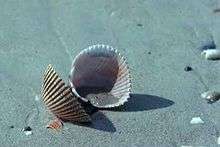Veneroida
| Veneroida | |
|---|---|
 | |
| Empty cockle shell, family Cardiidae | |
| Scientific classification | |
| Kingdom: | Animalia |
| Phylum: | Mollusca |
| Class: | Bivalvia |
| Subclass: | Heterodonta |
| Order: | Veneroida Gray 1854 |
| Families | |
|
See text | |
The Veneroida or veneroids are an order of mostly saltwater but also some freshwater bivalve molluscs. This order includes many familiar groups such as many clams and cockles that are valued for food, and a number of freshwater bivalves including the invasive species of zebra mussels.
Until recently, the Carditoida (cockles and their allies) were usually included in this group.
Description
Veneroids are generally thick-valved, equal valved, and isomyarian (that is, their adductor muscles are of equal size). Three main hinge teeth are characteristic of the subclass Heterodonta to which this order belongs. Many species are active rather than sessile. However they tend to be filter feeders, feeding through paired siphons, with a characteristic folded gill structure adapted to that way of life.
In 2002, Gonzalo Giribet and Ward Wheeler suggested that the orders Myoida and Veneroida were not monophyletic.[1] The World Register of Marine Species (WoRMS) currently divide the taxa contained in Veneroida between two orders, Cardiida (for Cardioidea and Tellinoidea) and Venerida (for the other superfamilies).[2][3]
Taxonomy
Order: Veneroida
- Superfamily: Arcticoidea
- Family: Arcticidae
- Family: Trapezidae
- Superfamily: Corbiculoidea
- Family: Corbiculidae
- Superfamily: Cyamioidea
- Family: Cyamiidae
- Family: Neoleptonidae
- Family: Sportellidae
- Superfamily: Glossoidea
- Family: Glossidae
- Superfamily: Cardioidea
- Family: Cardiidae
- Family: Hemidonacidae
- Species: Hemidonax pictus and others
- Superfamily: Chamoidea
- Family: Chamidae
- Superfamily: Galeommatoidea
- Family: Galeommatidae
- Family: Kellidae
- Family: Lasaeidae
- Family: Leptonidae
- Family: Montacutidae
- Superfamily: Mactroidea
- Family: Cardiliidae
- Family: Mactridae
- Family: Mesodesmatidae
- Superfamily: Tellinoidea
- Family: Donacidae
- Family: Pharidae
- Family: Psammobiidae
- Family: Semelidae
- Family: Tellinidae
- Family: Solecurtidae
- Superfamily: Ungulinoidea
- Family: Ungulinidae
- Superfamily: Cyrenoididae
- Family: Cyrenoididae
- Superfamily: Veneroidea
- Family: Petricolidae
- Family: Turtoniidae
- Family: Veneridae
See also
External links
References
- ↑ Gonzalo Giribet and Ward Wheeler (November 2002). "On bivalve phylogeny: a high-level analysis of the Bivalvia (Mollusca) based on combined morphology and DNA sequence data". Invertebrate Biology. Wiley Online Library. 121 (4): 271–324. doi:10.1111/j.1744-7410.2002.tb00132.x.
- ↑ "Cardiida". MolluscaBase. World Register of Marine Species. 2018. Retrieved 2018-07-16.
- ↑ "Venerida". WoRMS. World Register of Marine Species. 2018. Retrieved 2018-07-16.
| Wikimedia Commons has media related to Veneroida. |
| Wikispecies has information related to Veneroida |